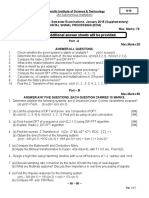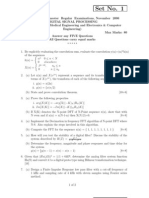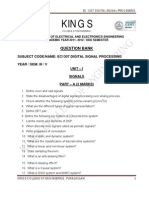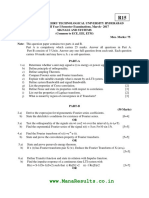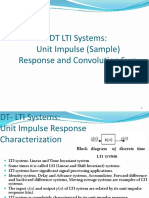Signals and Systems PDF
Uploaded by
Vishal GarimellaSignals and Systems PDF
Uploaded by
Vishal GarimellaINDIAN INSTITUTE OF TECHNOLOGY
Date: Mid-Semester Time: 2Hrs. Full Marks: 60 No. of students: 120
Spring Semester 2011-2012 Dept. Electronics & ECE Sub. No. EC21004
2"d Year B.Tech .. Sub. Name: Signals and Systems
Answer all questions. Answers should be brief, to the point and legible. Sketches wherever
appear should be neat and properly labeled. All parts of a question to be answered at one place.
All steps towards a solution must be unambiguously presented.
Ql. (a) Define and explain the significance of aliasing.
(b) Discuss accumulation and differencing properties of Discrete Time Fourier Transform and
comment on their High Pass or Low Pass nature.
(c) Explain various differences between FIR and IIR systems in discrete time domain. How do they
compare with impulse response of continuous time system. '
5+5+~
Q2. (a) Find if the discrete time system defined by y[ n] =~ is linear, causal, stable, invertible.
(b) Find impulse response of the system defined by 3y[n] + 4y[n- 1] + y[n- 2] = x[n] + x[n- 1]
(c) Find outputy[n] ofthe system defined below ifinputx[n] = 4-nu[n]
y[n+2]- 0.6y[n +I]- 0.16y[n] = 5x[n+2] where y[-1]=0,y[-2]=2514
4+5+6
Q3. (a) Define DTFS and inverse DTFS. Show how it can be expressed in terms of matrix
multiplication.
(b) Prove Parseval' s Theorem :
(c) Consider a discreet time system defined by 1.25 y[ n] - y[ n] = x[n]
(i) Findy 1[n] ifx[n] = x 1[n] = 64[n] and ploty[n] for n = 0 to 7.
(ii) Findy2[n] ifx[n] = x 2 [n] = 64[n]u[n] and ploty[n] for n = 0 to 7.
(iii) Comment on the difference betweeny 1[n] andy2 (n] 3+4+8
Q4. (a) Compare Continuous Time Fourier Transform and Discrete Time Fourier Transform.
(b) State and prove the time scaling property of Discrete Time Fourier Transform. How
upscaling and downscaling are different in terms of uniqueness?
(c) Consider following discreet time systems
(i) y[n] = {x[n] +x[n-1] +x[n-2]}/3
(ii) y[n] = x[n] -0.6 x[ n-1] + 0.4x[n-2]
Find their Discrete Time Fourier Transform; plot magnitude and phase response; calculate
their 3-dB cut-off frequency and comment on their utilities. 2+4+9
------------ All The Best ------------
You might also like
- DSP M.Tech, Avionics: ADSP Back Ground ExamNo ratings yetDSP M.Tech, Avionics: ADSP Back Ground Exam1 page
- Digital Signal Processing Tutorial QuestionsNo ratings yetDigital Signal Processing Tutorial Questions1 page
- Signals and Systems EC S4 B.Tech KTU 2017No ratings yetSignals and Systems EC S4 B.Tech KTU 20172 pages
- Questions For Assessment 1: Short AnswersNo ratings yetQuestions For Assessment 1: Short Answers2 pages
- Digital Signal Processing - Question BankNo ratings yetDigital Signal Processing - Question Bank3 pages
- BMS College of Engineering, Bangalore-560019: July / August 2017 Supplementary Semester ExaminationsNo ratings yetBMS College of Engineering, Bangalore-560019: July / August 2017 Supplementary Semester Examinations3 pages
- CS331 Digital Signal Processing Nov Dec 2005100% (1)CS331 Digital Signal Processing Nov Dec 20054 pages
- Department of Computer Engineering: x n π n R m)No ratings yetDepartment of Computer Engineering: x n π n R m)3 pages
- Inverse Trigonometric Functions (Trigonometry) Mathematics Question BankFrom EverandInverse Trigonometric Functions (Trigonometry) Mathematics Question BankNo ratings yet
- Student Solutions Manual to Accompany Economic Dynamics in Discrete Time, secondeditionFrom EverandStudent Solutions Manual to Accompany Economic Dynamics in Discrete Time, secondedition4.5/5 (2)
- Factoring and Algebra - A Selection of Classic Mathematical Articles Containing Examples and Exercises on the Subject of Algebra (Mathematics Series)From EverandFactoring and Algebra - A Selection of Classic Mathematical Articles Containing Examples and Exercises on the Subject of Algebra (Mathematics Series)No ratings yet
- Digital Signal Processing Question BankNo ratings yetDigital Signal Processing Question Bank15 pages
- Lecture-5 (ABSP) - Recursive and Non-Recursive Digital FiltersNo ratings yetLecture-5 (ABSP) - Recursive and Non-Recursive Digital Filters24 pages
- ECE-VII-DSP ALGORITHMS & ARCHITECTURE PartBNo ratings yetECE-VII-DSP ALGORITHMS & ARCHITECTURE PartB70 pages
- Digital Signal Processing (8SRN4/7IT01) : Unit Wise Course ContentsNo ratings yetDigital Signal Processing (8SRN4/7IT01) : Unit Wise Course Contents3 pages
- Digital Signal Processing Unit II: Digital Filters: Design and StructuresNo ratings yetDigital Signal Processing Unit II: Digital Filters: Design and Structures27 pages
- Practical No: - 07: Aim: To Write A Program To Design Butterworth Filter Using Bilinear Transformation TheoryNo ratings yetPractical No: - 07: Aim: To Write A Program To Design Butterworth Filter Using Bilinear Transformation Theory14 pages
- Real Time Audio Signal Processing TMS320C54X Assembly Code and ReportNo ratings yetReal Time Audio Signal Processing TMS320C54X Assembly Code and Report20 pages
- Revised Syllabus TY Electrical AY 2020 21 Modified 2020 04.08.2020No ratings yetRevised Syllabus TY Electrical AY 2020 21 Modified 2020 04.08.202035 pages
- DT LTI Systems: Unit Impulse (Sample) Response and Convolution SumNo ratings yetDT LTI Systems: Unit Impulse (Sample) Response and Convolution Sum45 pages
- Signal Generator Library: Module User's Guide C28x Foundation SoftwareNo ratings yetSignal Generator Library: Module User's Guide C28x Foundation Software80 pages



